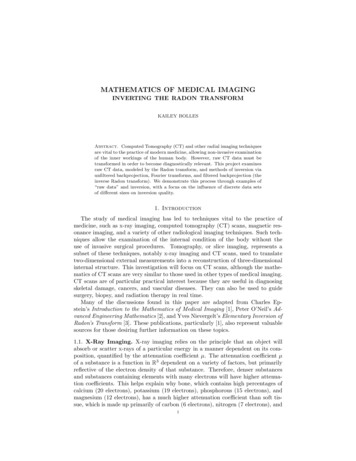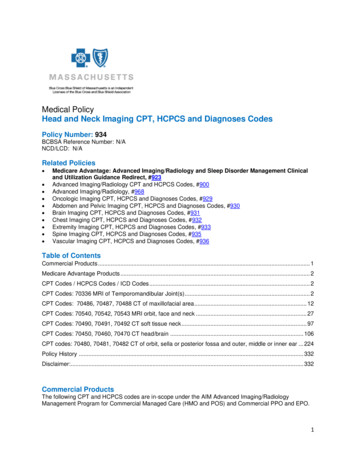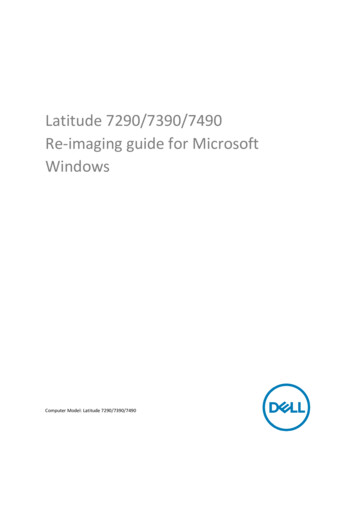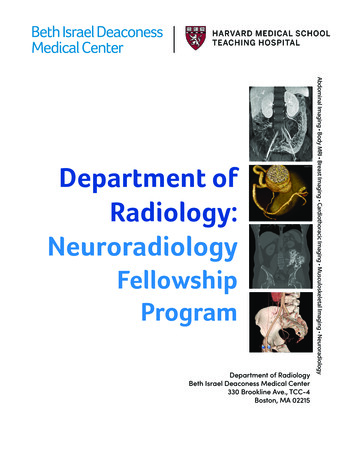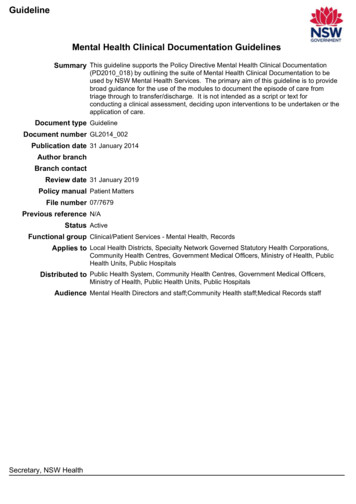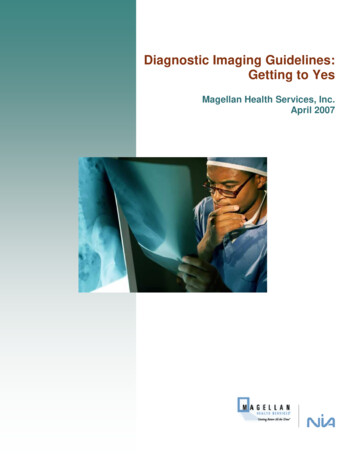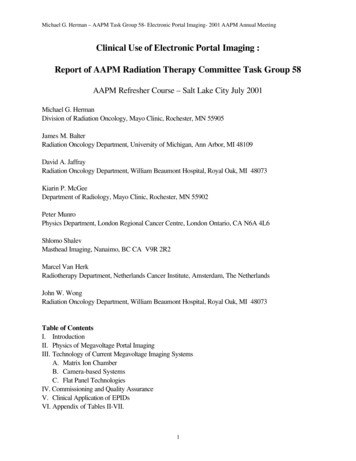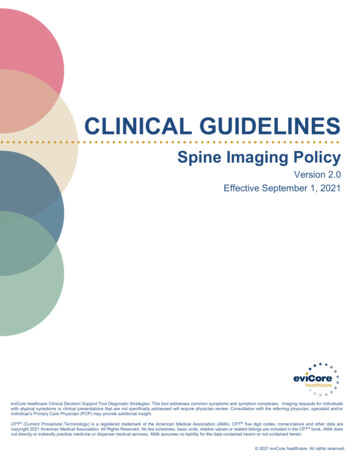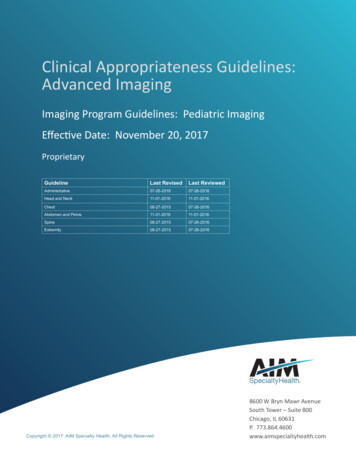
Transcription
Clinical Appropriateness Guidelines:Advanced ImagingImaging Program Guidelines: Pediatric ImagingEffective Date: November 20, 2017ProprietaryGuidelineLast RevisedLast ReviewedAdministrative07-26-201607-26-2016Head and bdomen and 6Extremity08-27-201507-26-2016Copyright 2017. AIM Specialty Health. All Rights Reserved8600 W Bryn Mawr AvenueSouth Tower – Suite 800Chicago, IL 60631P. 773.864.4600www.aimspecialtyhealth.com
Table of ContentsDescription and Application of the Guidelines.4Administrative Guidelines.5Ordering of Multiple Studies.5Pre-test Requirements.6Head & Neck Imaging.7CT of the Head – Pediatrics.7MRI of the Head/Brain – Pediatrics.14CTA/MRA Head: Cerebrovascular – Pediatrics.21Functional MRI (fMRI) Brain – Pediatrics.24PET Brain Imaging – Pediatrics.25CT Orbit, Sella Turcica, Posterior Fossa, Temporal Bone, including Mastoids – Pediatrics.26MRI Orbit, Face & Neck (Soft Tissues) – Pediatrics.29CT Paranasal Sinus & Maxillofacial Area – Pediatrics.33MRI Temporomandibular Joint (TMJ) – Pediatrics.36CT Neck for Soft Tissue Evaluation – Pediatrics.37CTA/MRA of the Neck – Pediatrics.40Chest Imaging.42CT Chest – Pediatrics.42CTA of the Chest (Non-Coronary) – Pediatrics.47MRI Chest – Pediatrics.49MRA of the Chest – Pediatrics.52Abdominal & Pelvic Imaging.54CT Abdomen – Pediatrics.54MRI Abdomen – Pediatrics.65MR Cholangiopancreatography (MRCP) Abdomen – Pediatrics.74CTA and MRA of the Abdomen - Pediatrics.76CT Pelvis – Pediatrics.79MRI Pelvis – Pediatrics.85CTA and MRA of the Pelvis – Pediatrics.91CT of the Abdomen and Pelvis Combination – Pediatrics.93CTA of the Abdomen and Pelvis Combination – Pediatrics.101Table of Contents – Pediatrics Copyright 2017. AIM Specialty Health. All Rights Reserved.2
Spine Imaging.103CT Cervical Spine – Pediatrics.103MRI Cervical Spine – Pediatrics.106CT Thoracic Spine – Pediatrics.110MRI Thoracic Spine – Pediatrics.113CT Lumbar Spine – Pediatrics.117MRI Lumbar Spine – Pediatrics.120MRA Spinal Canal – Pediatrics.124Extremity Imaging.125CT Upper Extremity – Pediatrics.125MRI Upper Extremity (Any Joint) – Pediatrics.128MRI Upper Extremity (Non-Joint) – Pediatrics.132CTA and MRA Upper Extremity – Pediatrics.135CT Lower Extremity – Pediatrics.137MRI Lower Extremity (Joint & Non-Joint) – Pediatrics.140CTA and MRA Lower Extremity – Pediatrics.147Table of Contents – Pediatrics Copyright 2017. AIM Specialty Health. All Rights Reserved.3
Description and Applicationof the GuidelinesAIM’s Clinical Appropriateness Guidelines (hereinafter “AIM’s Clinical Appropriateness Guidelines” or the“Guidelines”) are designed to assist providers in making the most appropriate treatment decision for a specificclinical condition for an individual. As used by AIM, the Guidelines establish objective and evidence-based, wherepossible, criteria for medical necessity determinations. In the process, multiple functions are accomplished: To establish criteria for when services are medically necessary To assist the practitioner as an educational tool To encourage standardization of medical practice patterns To curtail the performance of inappropriate and/or duplicate services To advocate for patient safety concerns To enhance the quality of healthcare To promote the most efficient and cost-effective use of servicesAIM’s guideline development process complies with applicable accreditation standards, including the requirementthat the Guidelines be developed with involvement from appropriate providers with current clinical expertiserelevant to the Guidelines under review and be based on the most up to date clinical principles and best practices.Relevant citations are included in the “References” section attached to each Guideline. AIM reviews all of itsGuidelines at least annually.AIM makes its Guidelines publicly available on its website twenty-four hours a day, seven days a week. Copies ofAIM’s Clinical Appropriateness Guidelines are also available upon oral or written request. Although the Guidelinesare publicly-available, AIM considers the Guidelines to be important, proprietary information of AIM, which cannotbe sold, assigned, leased, licensed, reproduced or distributed without the written consent of AIM.AIM applies objective and evidence-based criteria and takes individual circumstances and the local deliverysystem into account when determining the medical appropriateness of health care services. The AIM Guidelinesare just guidelines for the provision of specialty health services. These criteria are designed to guide bothproviders and reviewers to the most appropriate services based on a patient’s unique circumstances. In allcases, clinical judgment consistent with the standards of good medical practice should be used when applyingthe Guidelines. Guideline determinations are made based on the information provided at the time of the request.It is expected that medical necessity decisions may change as new information is provided or based on uniqueaspects of the patient’s condition. The treating clinician has final authority and responsibility for treatmentdecisions regarding the care of the patient and for justifying and demonstrating the existence of medical necessityfor the requested service. The Guidelines are not a substitute for the experience and judgment of a physicianor other health care professionals. Any clinician seeking to apply or consult the Guidelines is expected to useindependent medical judgment in the context of individual clinical circumstances to determine any patient’s careor treatment.The Guidelines do not address coverage, benefit or other plan specific issues. If requested by a health plan, AIMwill review requests based on health plan medical policy/guidelines in lieu of AIM’s Guidelines.The Guidelines may also be used by the health plan or by AIM for purposes of provider education, or to reviewthe medical necessity of services by any provider who has been notified of the need for medical necessity review,due to billing practices or claims that are not consistent with other providers in terms of frequency or some othermanner.CPT (Current Procedural Terminology) is a registered trademark of the American Medical Association (AMA). CPT five digit codes, nomenclature andother data are copyright by the American Medical Association. All Rights Reserved. AMA does not directly or indirectly practice medicine or dispensemedical services. AMA assumes no liability for the data contained herein or not contained herein.Guideline Description and Administrative Guidelines Copyright 2017. AIM Specialty Health. All Rights Reserved.4
Administrative Guideline:Ordering of Multiple StudiesRequests for multiple imaging studies to evaluate a suspected or identified condition and requests for repeatedimaging of the same anatomic area are subject to additional review to avoid unnecessary or inappropriateimaging.Simultaneous Ordering of Multiple StudiesIn many situations, ordering multiple imaging studies at the same time is not clinically appropriate because: Current literature and/or standards of medical practice support that one of the requested imaging studiesis more appropriate in the clinical situation presented; or One of the imaging studies requested is more likely to improve patient outcomes based on currentliterature and/or standards of medical practice; or Appropriateness of additional imaging is dependent on the results of the lead study.When multiple imaging studies are ordered, the request will often require a peer-to-peer conversation tounderstand the individual circumstances that support the medically necessity of performing all imaging studiessimultaneously.Examples of multiple imaging studies that may require a peer-to-peer conversation include:¾¾ CT brain and CT sinus for headache¾¾ MRI brain and MRA brain for headache¾¾ MRI cervical spine and MRI shoulder for pain indications¾¾ MRI lumbar spine and MRI hip for pain indications¾¾ MRI or CT of multiple spine levels for pain or radicular indications¾¾ MRI foot and MRI ankle for pain indications¾¾ Bilateral exams, particularly comparison studiesThere are certain clinical scenarios where simultaneous ordering of multiple imaging studies is consistent withcurrent literature and/or standards of medical practice. These include:¾¾ Oncologic imaging – Considerations include the type of malignancy and the point along the carecontinuum at which imaging is requested¾¾ Conditions which span multiple anatomic regions – Examples include certain gastrointestinal indicationsor congenital spinal anomaliesRepeated ImagingIn general, repeated imaging of the same anatomic area should be limited to evaluation following an intervention,or when there is a change in clinical status such that imaging is required to determine next steps in management.At times, repeated imaging done with different techniques or contrast regimens may be necessary to clarify afinding seen on the original study.Repeated imaging of the same anatomic area (with same or similar technology) may be subject to additionalreview in the following scenarios: Repeated imaging at the same facility due to motion artifact or other technical issues Repeated imaging requested at a different facility due to provider preference or quality concerns Repeated imaging of the same anatomic area (MRI or CT) based on persistent symptoms with no clinicalchange, treatment, or intervention since the previous study Repeated imaging of the same anatomical area by different providers for the same member over a shortperiod of timeGuideline Description and Administrative Guidelines Copyright 2017. AIM Specialty Health. All Rights Reserved.5
Administrative Guideline:Pre-Test RequirementsCritical to any finding of clinical appropriateness under the guidelines for specific imaging exams is adetermination that the following are true with respect to the imaging request: A clinical evaluation has been performed prior to the imaging request (which should include a completehistory and physical exam and review of results from relevant laboratory studies, prior imaging andsupplementary testing) to identify suspected or established diseases or conditions. For suspected diseases or conditions: Based on the clinical evaluation, there is a reasonable likelihood of disease prior to imaging; and Current literature and standards of medical practice support that the requested imaging study isthe most appropriate method of narrowing the differential diagnosis generated through the clinicalevaluation and can be reasonably expected to lead to a change in management of the patient; and The imaging requested is reasonably expected to improve patient outcomes based on currentliterature and standards of medical practice. For established diseases or conditions: Advanced imaging is needed to determine whether the extent or nature of the disease or conditionhas changed; and Current literature and standards of medical practice support that the requested imaging study is themost appropriate method of determining this and can be reasonably expected to lead to a change inmanagement of the patient; and The imaging requested is reasonably expected to improve patient outcomes based on currentliterature and standards of medical practice. If these elements are not established with respect to a given request, the determination ofappropriateness will most likely require a peer-to-peer conversation to understand the individual andunique facts that would supersede the pre-test requirements set forth above. During the peer-to-peerconversation, factors such as patient acuity and setting of service may also be taken into account.Guideline Description and Administrative Guidelines Copyright 2017. AIM Specialty Health. All Rights Reserved.6
Computed Tomography (CT) Head –PediatricsCPT Codes70450 CT of head, without contrast70460 CT of head, with contrast70470 CT of head, without contrast, followed by re-imaging with contrastStandard Anatomic Coverage From the skull base to vertex, covering the entire calvarium and intracranial contents Scan coverage may vary, depending on the specific clinical indicationTechnology Considerations MRI of the head is preferable to CT in most clinical scenarios, due to its superior contrast resolution and lack ofbeam-hardening artifact adjacent to the petrous bone (which may limit visualization in portions of the posterior fossaand brainstem on CT) Exceptions to the use of brain MRI as the neuroimaging study of choice and clinical situations where CT head ispreferred: initial evaluation of recent craniocerebral trauma evaluation of acute intracranial hemorrhage (parenchymal, subarachnoid, subdural, epidural) evaluation of calcified intracranial lesions osseous assessment of the calvarium, skull base and maxillofacial bones, including detection of calvarial andfacial bone fracturesCommon Diagnostic IndicationsThis section begins with general pediatric indications for CT Head, followed by neurologic signs and symptoms and vascularindications.General Head/BrainAbnormal imaging findingsFollow up of abnormal or indeterminate findings on a prior imaging study when required to direct treatmentAtaxia, congenital or hereditaryExamples include ataxia-telangiectasia, fragile X syndrome, congenital anomalies of the posterior fossa.Congenital or developmental anomalyDiagnosis or management (including perioperative evaluation) of a suspected or known congenital anomaly ordevelopmental conditionExamples include Chiari malformation, craniosynostosis, macrocephaly, and microcephaly. Ultrasound is required as the initial study to evaluate macrocephaly in patients under 5 months of age.CT Head – Pediatrics Copyright 2017. AIM Specialty Health. All Rights Reserved.7
Common Diagnostic IndicationsDevelopmental delayEvaluation of either of the following conditions: Cerebral palsy Global developmental delay, defined as significant delay or loss of milestones in at least two of the followingdomains: Activities of daily living Cognition Motor skills (gross/fine) Social/personal Speech/languageHearing lossEvaluation for a structural cause of conductive, sensorineural or mixed hearing lossNote:MRI is preferred for sensorineural hearing loss. CT is preferred for conductive or mixed hearing loss.Horner’s syndrome****Requires contraindication to MRIHydrocephalus/ventricular assessment Evaluation of signs or symptoms suggestive of increased intracranial pressure or hydrocephalus Ultrasound is required as the initial study in patients under 5 months of age Management of established hydrocephalus and ventricular shuntsInfectious diseaseDiagnosis or management (including perioperative evaluation) of parenchymal lesions associated with CNSinfectionInflammatory diseaseDiagnosis or management of inflammatory disease with CNS involvementLumbar puncture risk assessmentEvaluation prior to lumbar puncture when at least one of the following is present Papilledema Absent venous pulsations on funduscopic exam Altered mental status Abnormal neurological exam Evidence for meningeal irritationMultiple sclerosis and other white-matter diseases** Diagnosis of suspected demyelinating disease Management or surveillance of established disease**Requires contraindication to MRINeurocutaneous disordersDiagnosis or management (including perioperative evaluation) of CNS lesions associated with a knownneurocutaneous disorderExamples include neurofibromatosis, Sturge-Weber syndrome, tuberous sclerosis, and von Hippel-Lindau disease.PapilledemaCT Head – Pediatrics Copyright 2017. AIM Specialty Health. All Rights Reserved.8
Common Diagnostic IndicationsPseudotumor cerebriSeizures and epilepsyNeonatal/Infantile seizure (age 2 years or younger) Initial evaluation of seizure not associated with fever Periodic follow-up at 6-month intervals up to 30 months, if initial imaging study is non-diagnosticChildhood/Adolescent seizure (over age 2) When at least one of the following is present: Focal neurologic findings at the time of the seizure Persistent neurologic deficit in the postictal period Idiopathic epilepsy with atypical clinical course Partial seizures Seizures increasing in frequency and severity despite optimal medical management Electroencephalogram (EEG) findings inconsistent with idiopathic epilepsyComplex febrile seizure (age 6 months – 5 years) When either of the following is present: More than one seizure during a febrile period Seizure lasting longer than 15 minutesNote:Imaging is not generally indicated for simple febrile seizures.TraumaEvaluation following head trauma when at least one of the following is present: Non-accidental injury (NAI) Trauma associated with any of the following features: Altered mental status Change in behavior Vomiting Loss of consciousness History of high risk MVA or other mechanism of injury Scalp hematoma if less than 2 years of age Evidence of basilar skull fractureNote:This indication does not apply to patients with bleeding diathesis or intracranial shunts.Tumor (benign or malignant) Diagnosis of suspected tumor when supported by the clinical presentation Management (including perioperative evaluation) of established tumor when imaging is required to direct treatment Surveillance of established tumorCT Head – Pediatrics Copyright 2017. AIM Specialty Health. All Rights Reserved.9
Common Diagnostic IndicationsNeurologic Signs & SymptomsThis section contains indications for Bell’s palsy, headache, mental status change, syncope, vertigo/dizziness, and visualdisturbance.Advanced imaging based on nonspecific signs or symptoms is subject to a high level of clinical review.Appropriateness of imaging depends upon the context in which it is requested. At a minimum, this includes a differentialdiagnosis and temporal component, along with documented findings on physical exam.Additional considerations which may be relevant include comorbidities, risk factors, and likelihood of disease based on ageand gender.In general, the utility of structural brain imaging is limited to the following categories, each with a unique set of clinicalpresentations: Identification of a space occupying lesion or other focal abnormality (tumor, CVA) Detection of parenchymal abnormalities (atrophy, demyelinating disease, infection, ischemic change) Identification of ventricular abnormalities (hydrocephalus)There are a number of common symptoms or conditions for which the likelihood of an underlying central nervoussystem process is extremely low. The following indications include specific considerations and requirements whichhelp to determine appropriateness of advanced imaging for these symptoms.Bell’s palsy (peripheral facial weakness) When associated with additional neurologic findings suggestive of intracranial pathology Symptoms persisting beyond six (6) weeks in the absence of additional neurologic findingsHeadacheOnset within the past 30 days with no prior history of headache, when at least one of the following is present: Personal or family history of disorders that may predispose one to central nervous system (CNS) lesions andclinical findings suggesting CNS involvement (including, but not limited to, vascular malformations, aneurysms,brain neoplasms, infectious/inflammatory conditions such as sarcoidosis or personal history of meningitis andtuberculosis) Associated neurologic findings on physical exam Developmental delay Headache that awakens the patient repeatedly from sleep or develops upon awakening Sudden onset and severe headache (includes thunderclap headache or worst headache of life)Persistent or recurrent headache, when at least one of the following is present: Change in quality (pattern or intensity) of a previously stable headache Headache persisting for a period of up to 6 months duration and not responsive to medical treatment, and no priorimaging has been done to evaluate the headache Headache associated with at least one of the following: Abnormal reflexes Altered mental status Cranial nerve deficit Gait/motor dysfunction Nystagmus Seizure Sensory deficit Sign of increased intracranial pressure (increased head circumference, vomiting, papilledema, symptoms thatworsen with valsalvaNote:Imaging is not generally indicated for typical presentations of migraine.CT Head – Pediatrics Copyright 2017. AIM Specialty Health. All Rights Reserved.10
Common Diagnostic IndicationsMental status change (including encephalopathy), with documented evidence on neurologicexamSyncopeEvaluation for a structural brain lesion when associated with any of following: Seizure activity was witnessed or is highly suspected at the time of the episode. There is a documented abnormality on neurological examination. At least one persistent neurological symptom is presentVertigo and dizziness Evaluation of signs or symptoms suggestive of a CNS lesion Symptoms associated with abnormal audiogram or auditory brainstem responseNote:Vertigo or dizziness which is clearly related to positional change does not require advanced imaging.Visual disturbanceEvaluation for central nervous system pathology when suggested by the ophthalmologic examVascular indicationsThis section contains indications for aneurysm, cerebrovascular accident/transient ischemic attack, hemorrhage/hematoma,and other vascular abnormalities.Aneurysm Screening in asymptomatic, high-risk individuals At least two (2) first degree relatives with intracranial aneurysm or subarachnoid hemorrhage Presence of a heritable condition which predisposes to intracranial aneurysm (examples include autosomaldominant polycystic kidney disease and Ehlers-Danlos syndrome type IV) Diagnosis of suspected aneurysm based on neurologic signs or symptoms (for isolated headache, see Headacheindication) Management (including perioperative evaluation) of known (treated or untreated) intracranial aneurysm whenassociated with new or worsening neurologic symptoms Surveillance of known aneurysm in the absence of new or worsening symptoms Initial evaluation at 6–12 months following diagnosis, then every 1–2 years Follow-up after treatment with clips, endovascular coil or stentingCerebrovascular accident (CVA or stroke) and transient ischemic attack (TIA)Hemorrhage/hematomaOther vascular abnormalities Arteriovenous malformation (AVM) Cavernous malformation Cerebral vein thrombosis Dural arteriovenous fistula (DAVF) Dural venous sinus thrombosis Venous angiomaNote:CTA or MRA is generally preferred for these indications.CT Head – Pediatrics Copyright 2017. AIM Specialty Health. All Rights Reserved.11
References1.Accardo J, Kammann H, Hoon AH Jr. Neuroimaging in cerebral palsy. J Pediatr. 2004;145(2 Suppl):S19-S27.2.Alehan FK. Value of neuroimaging in the evaluation of neurologically normal children with recurrent headache. J ChildNeurol. 2002 Nov;17(11):807-809.3.Alexiou GA, Argyropoulou MI. Neuroimaging in childhood headache: a systematic review. Pediatr Radiol.2013;43(7):777-784.4.American Academy of Otolaryngology — Head and Neck Surgery Foundation. Choosing Wisely: Five ThingsPhysicians and Patients Should Question. ABIM Foundation; February 21, 2013. Available at www.choosingwisely.org5.American Academy of Pediatrics. Choosing Wisely: Five Things Physicians and Patients Should Question. ABIMFoundation; February 21, 2013. Available at www.choosingwisely.org6.American Academy of Pediatrics.Subcommittee on Febrile Seizures. Febrile seizures: Guideline for the neurodiagnosticevaluation of the child with a simple febrile seizure. Pediatrics. 2011 Feb;127(2):389-394.7.American Association of Neurological Surgeons. Choosing Wisely: Five Things Physicians and Patients ShouldQuestion. ABIM Foundation; 2014. Available at www.choosingwisely.org8.Ashwal S, Michelson D, Plawner L, Dobyns WB, Quality Standards Subcommittee of the American Academy ofNeurology and the Practice Committee of the Child Neurology Society. Practice parameter: Evaluation of the child withmicrocephaly (an evidence-based review): report of the Quality Standards Subcommittee of the American Academy ofNeurology and the Practice Committee of the Child Neurology Society. Neurology. 2009;73(11):887-897.9.Ashwal S, Russman BS, Blasco P, et al. Practice parameter: diagnostic assessment of the child with cerebral palsy:report of the Quality Standards Subcommittee of the American Academy of Neurology and the Practice Committee ofthe Child Neurology Society. Neurology. 2004;62(6
Nov 20, 2017 · Head and Neck 11-01-2016 11-01-2016 Chest 08-27-2015 07-26-2016 . Common Diagnostic Indications This section begins with general pediatric indications for CT Head, followed by neurologic signs and symptoms and vascular indications. General Head

